Keeping Track of Time
Bridges, factories, fire stations, rural land – let’s take one more train ride along the Malayan Railway line that runs through Singapore.


Bridges, factories, fire stations, rural land – let’s take one more train ride along the Malayan Railway line that runs through Singapore.
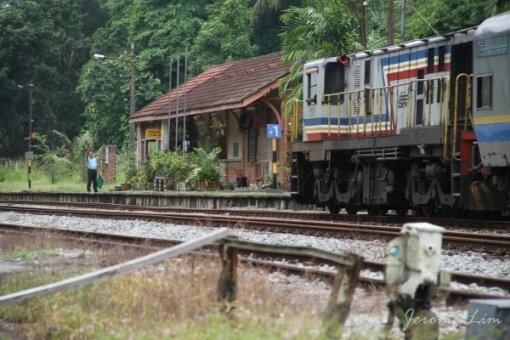
A train passing Bukit Timah Station.
My earliest impressions of the Malayan Railway were formed perhaps not so much by the station at Tanjong Pagar, but by the two black steel truss railway bridges that seem to give the area of Bukit Timah that they cross its character. I often passed under the bridges as a child, seated in the backseat of my father’s car on the many trips he took us on to and from the Causeway and to Jurong, or to the Teck Whye area to visit a friend of my mother’s who ran an orchid farm.
Each time I passed under, my attention would be drawn to the heavy steel trusses, sometimes hoping that I could see a train traversing one of them. The bridges would serve as a landmark for me on the long road journeys from the Causeway. The stretch from the Causeway down the Woodlands and Bukit Timah Roads always seemed endless, particularly having had been seated in the backseat for a large portion of the journey along the winding roads north of the Causeway, taking us past the monosodium glutamate processing ponds close to the Causeway and the Metal Box factory, then Bukit Panjang Circus and Bukit Gombak, and further on past Boys Town before the first of the two black bridges came into view.
Seeing the first meant that the long and boring part of the journey would be coming to its end, and I could look forward to seeing the Hume Factory, Ford Factory, and Magnolia Dairies on the hill, before the Bukit Timah Fire Station came into sight and with it, the huge Green Spot bottle at the entrance of the Amoy Canning Factory that I would never fail to look out for.

One of the two steel truss bridges that give the Bukit Timah area its distinct character.
Passing under the bridges and catching an occasional glimpse of a train on one of them would also bring with it a desire to make a train journey of my own, something that I only managed to do later in life. When I did finally embark on that very first train journey and on my subsequent journeys, I did find that there was a lot more than the bridges that captivated me. The train rides always provided an opportunity to catch a glimpse of a Singapore that would otherwise remain hidden to me, with the route that the train takes meandering through parts of Singapore that could very well be in another world.
Two spots came to my attention on that first ride, having been provided with a good glimpse of them from the unscheduled stops that the train made prior to reaching the Causeway. The two were a short distance apart, on either side of the first of the railway bridges that cross Bukit Timah Road, the first being at the Bukit Timah Station just before the bridge, a station that I had hitherto not known about, and the second just after the bridge – at the stretch just behind the Yeo Hiap Seng factory.

A southbound train crossing the bridge near the site of the former Yeo Hiap Seng factory.

The trains to and from Tanjong Pagar take a route through some untouched parts of Singapore.
Having caught a good look at Bukit Timah Station that very first time in the dim illumination it was provided with, I was fascinated, seeking to find out more about it when I got back to Singapore. From what I could see of it, it had looked to me like one of the little rural stations that might have depicted in one of the Ladybird books that I had spent my early years reading, one that could be one used to model a miniature station for one of those model train sets that I had often looked longingly at in the toy department of Robinson’s. It was in future train journeys in the daylight that I would get a better glimpse of it, being something that I would never tire looking out for on all my journeys by train.
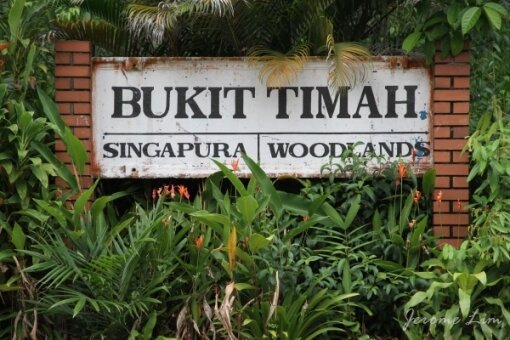
Bukit Timah Station is a little known about station in Singapore, off Bukit Timah Road.

Bukit Timah Station could pass off for one of the little stations on a model train set.
The station, I was to learn, was built in 1932 as part of a realignment of the original railway line which had run from Woodlands down to its terminal at Tank Road via Newton Circus. The realignment or “deviation” as it was referred to then, was carried out at considerable expense at the end of the 1920s, partly motivated by the need to elevate certain portions of the track as the old line had been prone to being overrun by the frequent floods that afflicted the low-lying Bukit Timah corridor the line ran through, and at the same time allowing what were considered to be dangerous level crossings to be minimised.
The realignment also allowed the construction of a brand new and much grander terminal at Tanjong Pagar, one that could be considered as befitting of its status as the southern terminal of the railway line, and more importantly, as the gateway from the colonies in the Malayan Peninsula to Europe and also to the Far East by sea. Bukit Timah Station was also strategically placed to serve what was to prove to be a very lucrative service – the transport of racehorses to and from the racing circuits on the peninsula and the island, being a stone’s throw from the old Turf Club at Bukit Timah. The deviation of 1932 also gave us the two wonderful bridges that were to lend themselves towards giving the area its distinct flavour.
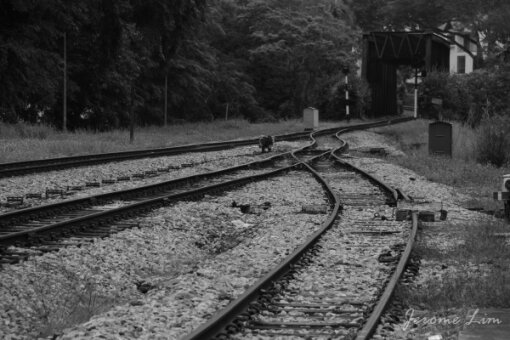
The distinctive truss bridges over Bukit Timah Road and Bukit Timah Station were completed in 1932 as part of a deviation to the rail line that cost a considerable sum of money.

The road out to Bukit Timah Road from the station ... a route that would have been taken by the many racehorses that were transported on the train to Singapore, bound for the old Turf Club.
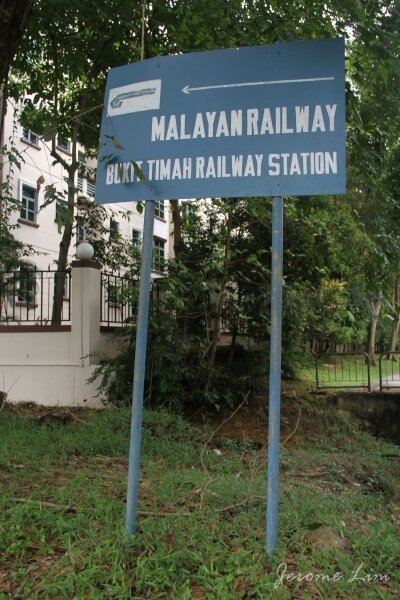
A old signboard pointing towards Bukit Timah Station from the main road.
The stretch after crossing the bridge over Bukit Timah and Dunearn Roads I had a good view of through not what one might have called a stop, but a series of stops and starts. That gave me the opportunity to see what had occupied the narrow strip of land wedged between what was the railway track, the old Yeo Hiap Seng factory on one side and Rifle Range Road on the other.
The strip was then packed with some of the last remaining squatters that had survived in the 1990s, something I hadn’t been aware of until I had peered out of the window on that first train journey, right into what were the illuminated dwellings of the squatters which had seemed to be only an arm’s length from me. Much of Singapore had by then been cleared of squatters, most having by the time the 1990s arrived, been resettled in the highrise public housing that marks most of the landscape of once-rural Singapore. It was then difficult to evict the squatters with the then poor relations between Singapore and the Malaysian government that had effectively owned the corridor of land that the trains run through.
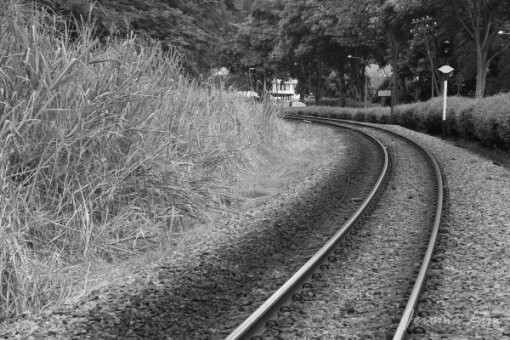
The bend in the tracks where the Yeo Hiap Seng factory was.

The narrow strips of land along the tracks in the area were occupied by the wooden shacks of squatters living on land belonging to the Malayan Railway.
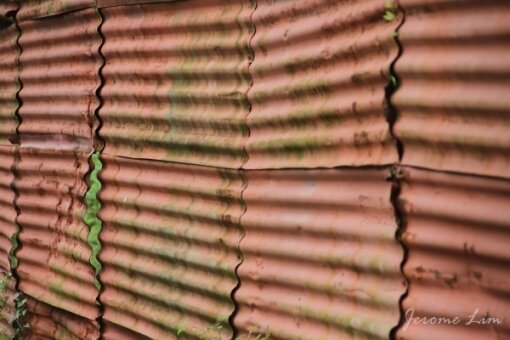
Corrugated zinc sheets and wooden shacks were once a common sight along much of the railway line.

Another view of the tracks around Rifle Range Road which were once lined with the dwellings of squatters living on the Railway land.
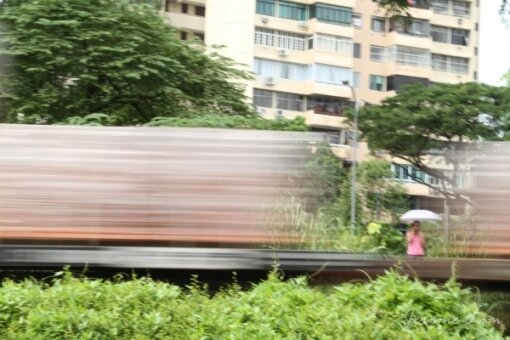
A train carrying bricks passing a popular shortcut from Jalan Anak Bukit to Rifle Range Road, one that would have been used by squatters living in the area.

The shortcut from Jalan Anak Bukit over the tracks to Rifle Range Road.

Looking north from Rifle Range Road ... the train takes a path through much of a Singapore that would otherwise remain unseen.
Looking back, I suppose one of the things that came from having a Malaysian railway line operating through Singapore was that it allowed large tracts of the land along the railway and much of the areas around to remain undeveloped and retain the rustic charm that has been lost in much of our island through the rapid modernisation that has overtaken us since our independence, much of which I guess would soon be consigned to the past with the recent agreement on the land swap and the redevelopment of the Railway land.
There isn’t much time left, I guess, for us to savour the rustic charm of the Railway land and some of the buildings that lay around it. I would certainly like to take a last train journey, to take all this in for one last time and to say a fond farewell to what will soon be lost.
This post was originally published in September 2010 in The Long and Winding Road [4], which made it into the 2010 finals for Best Individual Blog in the Singapore Blog Awards. He was also one of 10 bloggers invited to Hong Kong recently by the HK Tourism Board.
